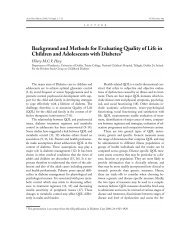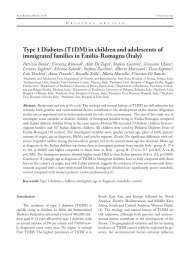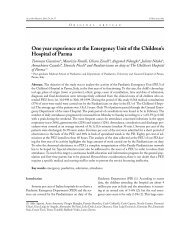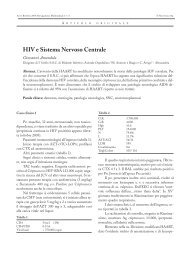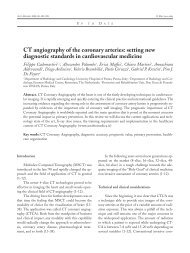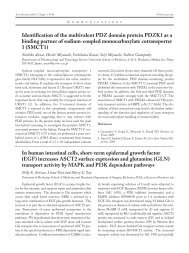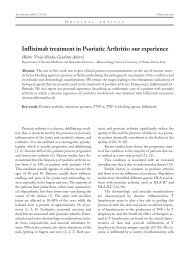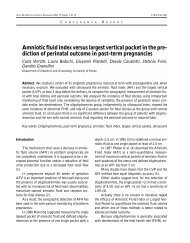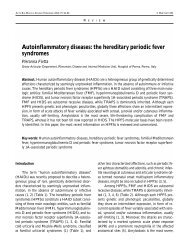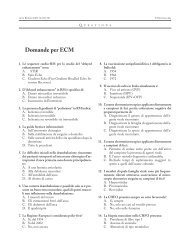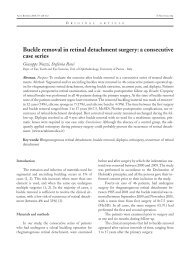View - Acta Bio Medica Atenei Parmensis
View - Acta Bio Medica Atenei Parmensis
View - Acta Bio Medica Atenei Parmensis
Create successful ePaper yourself
Turn your PDF publications into a flip-book with our unique Google optimized e-Paper software.
ACTA BIOMED 2005; 76; Suppl. 3: 7-13 © Mattioli 1885<br />
L E C T U R E<br />
Diabetes in the young: from Leicester to Siena (via Oslo,<br />
Bethesda and Hvidore)<br />
Peter G.F. Swift<br />
Consultant Paediatrician (Diabetes/Endocrinology), Children’s Hospital, Leicester Royal Infirmary, Leicester, LE1 5WW, UK<br />
(Available free-on line at: www.actabiomedica.it)<br />
“The discovery of insulin was only the beginning,<br />
diabetes was a far more complicated disease than anyone<br />
had realised…”<br />
This quotation is taken from “The Discovery of<br />
Insulin” a wonderfully descriptive book by Michael<br />
Bliss published in 1982 (1). This book graphically describes<br />
the first patient, a child, chosen to receive an<br />
insulin preparation in January 1922. Leonard Thompson,<br />
aged 14 years, was given an extract of beef pancreas<br />
in a volume of 7.5 ml into each buttock. It was<br />
described as being “a thick brown muck”. The blood<br />
sugar decreased marginally as did the 24 hour urinary<br />
excretion of glucose although there was no clinical benefit<br />
evident. A sterile abscess developed at the site of<br />
one of the injections!<br />
This was only the beginning and since the 1970’s<br />
pure uncontaminated manufactured insulin preparations<br />
have been available and the importance of providing<br />
children at diagnosis with “a good start with confident,<br />
clear, positive messages cannot be over-emphasized”<br />
(2). In Leicester, UK, our philosophy of treatment<br />
has certainly been consistent with the ideal of<br />
providing “a good start” by utilising the idea of managing<br />
children with diabetes on an ambulatory basis<br />
and trying not to admit them to hospital (3).<br />
In the UK outpatient management of children<br />
with diabetes was initiated in the early 1950’s in Leicester<br />
by Dr. Joan Walker and is described in her superb<br />
book (4). In 1950 she made the unique appointment<br />
of a community based health visitor (community<br />
nurse) attached to the hospital diabetic clinic and<br />
whose innovative work enabled most children to be<br />
treated out of hospital helping them to give their first<br />
injections at home in the family environment so that<br />
“education begins immediately… when they are at<br />
their most receptive” (5).<br />
Our diabetes team has built on this early experience<br />
and it has been fully described elsewhere (3, 6).<br />
Over the decades ambulatory care has become more<br />
acceptable particularly in America and indeed parts of<br />
Europe including Italy (7). Daneman carried out a<br />
worldwide systematic review of ambulatory vs inpatient<br />
care, reporting that the re-admission rate was<br />
lower in those not admitted to hospital at diagnosis,<br />
glycated haemoglobin was equal or lower, costs were<br />
lower and psychosocial outcomes slightly better (8).<br />
The question should always be asked “why admit children<br />
to hospital if there is an expert team available to<br />
manage diabetes outside the hospital in the patient’s<br />
home environment”.<br />
We believe that non-hospital based, ambulatory<br />
care during the traumatic early educational period of<br />
management avoids undue disruption of fundamentally<br />
important and supportive family relationships<br />
within the home environment. It also helps to firmly<br />
establish long term trusting relationships with the<br />
treatment team.<br />
Ambulatory management at diagnosis has been<br />
criticised suggesting that it trivialises the seriousness<br />
of diabetes (9). Our experience in Leicester would<br />
completely contradict such a view and we would like<br />
to think that our approach helps not only to provide a<br />
confident and supportive initiation but also emphasises<br />
the importance of good metabolic control right
8 P.G.F. Swift<br />
from the start, thus improving the prospects of preventing<br />
both short term crises and long term vascular<br />
complications.<br />
Preventing vascular complications<br />
In 1977 it was reported that strict glucose control<br />
was able to prevent diabetic retinopathy. But this was<br />
in dogs (10)! Such a statement had been the subject of<br />
debate and controversy in human (and particularly<br />
childhood) diabetes for many years. It was only in<br />
1982 that the Oslo study was initiated to try to answer<br />
this debate. Forty-five young people, diagnosed with<br />
type 1 diabetes between the ages of 10 and 29 years,<br />
were recruited. The average age of participants at the<br />
start of the Oslo study was 24 years, with duration of<br />
diabetes more than 7 years. They were divided into 3<br />
groups: conventional therapy, insulin pumps, and multiple<br />
injection therapy. It was worrying that initially<br />
with more intensive therapy the tightening of blood<br />
glucose control in this and other studies, was associated<br />
with a worsening of retinopathy (11-13). This<br />
phenomenon had been termed “the paradox of normoglycaemic<br />
re-entry” (14). Fortunately, in Oslo this<br />
was found to be transient. (15). The improvement in<br />
retinal microvascular complications with continued<br />
intensified insulin treatment was also noted in the<br />
KROC study in London (16) and in the Steno Copenhagen<br />
studies (17) and its aetiopathogenesis has<br />
been the subject of speculation and debate (18).<br />
In the Oslo study, after 4 years of improved control<br />
with near normoglycaemia and better glycated<br />
haemoglobin a delayed onset of microvascular complications<br />
was recorded. It was shown that both CSII<br />
and multiple injection therapy were superior to conventional<br />
therapy (19). Thereafter all patients were<br />
encouraged to use intensified insulin regimens and<br />
throughout the long term follow up of the study<br />
group, HbA 1 c values have been measured.<br />
A similar long-term intervention study in adults<br />
with diabetes of 17 years duration was set up in<br />
Stockholm in 1982. The group was divided into an intensive<br />
group seeing the same physician every two<br />
weeks for a period of time and taking at least 3 injections<br />
of insulin per day. At the 7.5 year follow up the<br />
differences between conventional therapy and intensive<br />
therapy showed HbA 1 c 8.5 vs 7.1 %, retinopathy 52<br />
vs 27%, nephropathy 17 vs 2% but slightly more hypoglycaemia<br />
in the intensive group (20). This further<br />
study confirmed once again that the lower HbA 1 c resulted<br />
in lower microvascular complications.<br />
The remarkable Oslo study has more recently focussed<br />
on macrovascular disease with further follow up<br />
after 18 years. Intracoronary ultrasound studies have<br />
shown silent coronary atheromatosis in 100% of the<br />
29 patients studied at an average age of 43 years, duration<br />
of diabetes 30 years and average HbA 1 c 8.8%.<br />
Thyrty-five% of the patients had 40% or more stenosis<br />
of one or more of the coronary arteries (21). It was<br />
noted that for every increment in :<br />
• HbA 1 c of 1% there was a 6% increase in coronary<br />
artery stenosis<br />
• serum cholesterol of 1 mmol/l there was a 10%<br />
increase in coronary artery stenosis<br />
• duration in diabetes of 10 years there was a 16%<br />
increase in coronary artery stenosis.<br />
At the time of the start of the Oslo study, 195<br />
adolescents were being recruited into the diabetes<br />
control and complications trial (DCCT Bethesda) in<br />
the N. America. They were aged 13 to 17 years at entry<br />
and were studied for an average of 7.4 years. The<br />
intensive therapy group received extraordinarily intensive<br />
management with either multiple injections or<br />
continuous insulin infusions, self-monitoring of blood<br />
glucose at least 4 times per day, strict goals and targets,<br />
at least weekly telephone contact with a diabetes professional,<br />
monthly visits to the clinic and monthly<br />
HbA 1 c measurements. The impressive results of this<br />
arm of the study were reported in 1994 (22), showing<br />
a clear separation between the intensive group achieving<br />
an average HbA 1 c 8.1% (1% higher than in the<br />
adult DCCT group) and the conventional group having<br />
an average HbA 1 c 9.8%.<br />
This group of adolescents showed that with the<br />
sustained decrease in HbA 1 c of around 2% there was a<br />
reduction in the risks of microvascular complications<br />
by 60 to 70%. This result was deemed to outweigh the<br />
adverse effects of a three-fold increase in severe hypoglycaemic<br />
events and a two-fold risk of becoming over<br />
weight. It was important to note that in the DCCT<br />
there was no threshold HbA 1 c below which complica-
Diabetes in the young: from Leicester to Siena<br />
9<br />
tions did not occur. The risks of complications applied<br />
at all levels of HbA 1 c and what has become most important<br />
is that the total glycaemic exposure both in duration<br />
and level are important in the development of vascular<br />
complications (23). This report from the DCCT<br />
Research Group also emphasises that the risks of complications<br />
with HbA 1 c 9% in the intensive group are<br />
less than with HbA 1 c 8% in the conventional therapy<br />
group. Reasons for this finding are uncertain but<br />
(a) perhaps there is less variability of blood glucose<br />
control in the intensive group compared to<br />
the conventional therapy group<br />
(b) it may point to the importance of post prandial<br />
blood glucose levels and total glycaemic<br />
exposure.<br />
Since the closure of DCCT the Epidemiology of<br />
Diabetes Interventions and Complications (EDIC)<br />
Research Group has continued surveillance and has<br />
reported that four years after the end of the DCCT<br />
the HbA 1 c of the intensive therapy group has deteriorated<br />
somewhat, from 7.2% to 7.9%. The conventional<br />
therapy group, choosing more intensive therapy following<br />
the DCCT, has improved from 9.1% to 8.2%,<br />
thus showing virtual equality of glycated haemoglobin<br />
in the two groups. However, after four years the incidence<br />
of retinopathy and nephropathy remained lower<br />
in the original intensive therapy group showing the<br />
importance of preceding longer-term metabolic control<br />
of intensive therapy (24).<br />
Furthermore the EDIC study has looked at intensive<br />
diabetes treatment and carotid intima-media<br />
thickness (IMT). It is assumed that IMT correlates<br />
with atherosclerosis (25). In the EDIC study IMT<br />
correlated with blood pressure, smoking, LDL/HDL<br />
levels, microalbuminuria and also with the mean<br />
HbA 1 c during the DCCT. Six years after DCCT the<br />
intensive therapy group continued to have significantly<br />
less IMT than the conventional group (26).<br />
Follow up studies by the DCCT Research Group<br />
have also tried to define the relationship between<br />
blood glucose levels and HbA 1 c. In the study of Rohlfing<br />
et al. (27) 26,000 data points were analysed using<br />
the 7-point mean monthly plasma glucose levels of each<br />
individual and compared them with the HbA 1 c<br />
measurements throughout the DCCT. This confirms<br />
that the preceding 30 days of blood glucose levels contribute<br />
at least 50% towards HbA 1 c levels; the fasting<br />
blood glucose tends to underestimate the HbA 1 c ; but<br />
afternoon and evening blood glucose showed better<br />
correlation with HbA 1 c. Post-prandial blood glucose<br />
contributes appreciably to HbA 1 c and in order to<br />
achieve an HbA 1 c of 7% one would have to achieve a<br />
mean plasma glucose over some weeks of around 7 or<br />
8 mmol/l (27).<br />
Conclusion<br />
All these studies, particularly those comparing<br />
intensive diabetic treatment with conventional therapy,<br />
have shown conclusively that not only does better<br />
metabolic control reduce the risks of microvascular<br />
complications (retinopathy, nephropathy and neuropathy)<br />
but also lowers the risks of the life-threatening<br />
macrovascular complications of atherosclerosis. As<br />
atherosclerosis is now the most common cause of premature<br />
death in young people with diabetes (28), these<br />
results are of great importance and should be a<br />
major motivation for paediatricians in organising care<br />
which encourages and empowers young patients to<br />
achieve better metabolic control. The results have<br />
been associated with total glycaemic exposure and this<br />
has an effect at any age. It is wrong for paediatricians<br />
to assume that the prepubertal age in diabetes is any<br />
way safe from the risk of developing later vascular<br />
complications (29, 30).<br />
In the USA as in other parts of the world the influence<br />
of the DCCT has been immense. In 1983 the<br />
average HbA 1 c in one large clinic in the USA was<br />
8.7%. When the DCCT was reported in 1993 the<br />
mean HbA 1 c was 8.45%. Since 1999 the average<br />
HbA 1 c in the same clinic has been just in excess of<br />
7.9% showing a gratifying reduction in glycated haemoglobin<br />
with reduced risks of complications.<br />
Outcome measures<br />
In 1994 an international group of paediatricians<br />
initiated the Hvidore Study Group on Childhood<br />
Diabetes. The first study was to measure the HbA 1 c<br />
levels achieved in each of 22 centres. The results of
10 P.G.F. Swift<br />
Figure 1. International survey of childhood diabetes<br />
(Hvidore Study Group. Diab Care 2001; 24: 1342-47)<br />
this were published in 1997 (31) and the figure shown<br />
published in 2001 (32). These results showed substantial<br />
differences in HbA 1 c levels achieved between the<br />
22 international centres, some achieving excellent<br />
mean HbA 1 c’s below 8% whereas a number of centres<br />
had mean HbA 1 c levels above 9.2%.<br />
The reasons for such centre differences have been<br />
difficult to tease out. On relatively superficial analysis<br />
it would seem that resources, facilities and clinic structures<br />
in the centres do not explain the differences. A<br />
further study in 1998 compared the insulin injection<br />
regimens in 872 adolescents between the years 1995-<br />
1998 which was really a comparison of adolescents<br />
aged 11 years compared with how they were 3 years<br />
later. There was no significant change in HbA 1 c whereas<br />
the pattern of injection regimens changed considerably<br />
between these two times. In 1995 over 50% of<br />
children were using only 2 injections a day compared<br />
with 27% in 1998. In contrast in 1995 17% were on 4<br />
injections or more compared with 38% in 1998. Therefore,<br />
despite changes in insulin injection regimens<br />
no change of metabolic control was recorded (33).<br />
One question that is often asked is whether those<br />
centres with significantly better metabolic control<br />
have higher levels of hypoglycaemia. The Hvidore<br />
Study has shown that those centres that have the best<br />
metabolic control also have the lowest incidence of severe<br />
hypoglycaemia throughout the range of HbA 1 c<br />
levels and moreover the better centres in 1995 also have<br />
better control in 1998 (32). These two results indicate<br />
that some centres are able to achieve better metabolic<br />
control both in the short and long-term and have<br />
reduced levels of hypoglycaemia indicating that<br />
these centres of excellence have methods of management<br />
to which we should all aspire.<br />
The Hvidore Study Group has also shown that<br />
the better metabolic control is associated with better<br />
levels of quality of life thus indicating that intensifying<br />
treatment regimens in order to improve metabolic<br />
control is not detrimental to the quality of life of<br />
young people (34).<br />
In order to understand further the differences<br />
between centres, a unique anthropological qualitative<br />
study was performed by members of the Hvidore<br />
Study Group. Observational studies were performed<br />
to compare the clinics in Chieti (HbA 1 c 7.6%) and<br />
Dundee (HbA 1 c 9.1%). There seemed to be major<br />
cultural and social differences between the clinics.<br />
Chieti illustrated the egalitarian Italian society with<br />
strong persistent family values whereas Dundee was<br />
characterised by the libertarian and individualistic<br />
current culture of the UK. In Italy with the acceptance<br />
of more prolonged family support there was much<br />
better matching between the goals of diabetes treatment<br />
and expectations. In contrast, in Dundee, independence<br />
was given to young people too early when<br />
they were unable to accept responsibility and amongst<br />
families and professionals there was an expectation<br />
of non-adherence to treatment regimens. The observations<br />
suggested that adolescents’ feelings of empowerment<br />
over diabetes are influenced by differences<br />
in the cultural matching and mis-matching of health<br />
strategies between young people and their health carers<br />
(35). In Chieti there appeared to be a provision of<br />
healthcare that takes advantage of the macro (diet, family<br />
structure) and micro cultural factors (family support,<br />
sense of individuality within the collective family,<br />
choice of the degree of support). In Dundee attempts<br />
to provide similar diabetes strategies to improve<br />
glycaemic control conflicted with the underlying<br />
macro and micro cultural factors inherent in UK society.<br />
It was also suggested that in Dundee in order to<br />
improve clinical outcomes professionals would need<br />
to overcome the negative cultural influences by developing<br />
innovative strategies. This would seem to be<br />
difficult in the context of many of the societal fashions<br />
in the UK.
Diabetes in the young: from Leicester to Siena<br />
11<br />
One of the universally accepted but least well researched<br />
influences on diabetes care and metabolic<br />
control have been diet and nutrition although in Italy,<br />
Pinelli and colleagues have been active in the paediatric<br />
nutritional field (36). The first Hvidore study indicated<br />
that the global problem of increasing BMI<br />
was seen in children with diabetes. It was shown that<br />
the nadir of BMI which is said to occur between the<br />
ages of 5 and 7 in non-diabetic children was being reached<br />
at an earlier age between 4 and 5 years of age in<br />
children with diabetes and subsequently the average<br />
BMI of this large study group was higher than nondiabetic<br />
children (37).<br />
In the DCCT, diet and nutritional behaviour were<br />
found to have a significant effect on HbA 1 c. The diet<br />
behaviours which improved the glycated haemoglobin<br />
by an average of nearly 1% were that patients adhered<br />
to a meal plan, they adjusted food and insulin if hyperglycaemic<br />
and treated episodes of hypoglycaemia more<br />
appropriately. They also had more consistent snacking<br />
behaviour and did not have frequent night time snacks<br />
(38). With respect to both short-term and long-term<br />
diabetes outcomes certain communities start with an<br />
advantage over others in that WHO data suggests that<br />
the Mediterranean countries such as Italy have higher<br />
intakes of fruit and vegetables and lower intake of saturated<br />
fat (39). Moreover if one looks at the percentage<br />
of 15 year olds who eat sweets and chocolates everyday,<br />
in the UK countries something like 70 or 80% of<br />
youngsters eat sweets everyday whereas in the Scandinavian<br />
countries the figures are more like 30 or 40%.<br />
Our colleagues from Leicester and Verona have compared<br />
the quality of food in Italy and UK and found<br />
that Italian youngsters are far more likely to eat<br />
healthier low fat and fruit and vegetable snacks than in<br />
the UK where high fat potato crisps and snack bars are<br />
more likely to be consumed.<br />
It is these cultural variations added to differences<br />
in clinical approach which make diabetes management<br />
and outcomes so different in various countries.<br />
International collaboration<br />
It is pleasing to report that much of the collaborative<br />
work that has occurred between individuals<br />
and groups throughout the world has occurred as<br />
consequence of the meetings of the International Society<br />
for Pediatric and Adolescent Diabetes<br />
(ISPAD). ISPAD is the only global advocate for children<br />
with diabetes, it works closely with the IDF and<br />
members have important roles within the IDF.<br />
ISPAD makes major contributions in the science,<br />
education and advocacy for children and adolescents<br />
with diabetes. The well-reviewed and accepted consensus<br />
guidelines (2) were published in 2000 and have<br />
now been translated into 11 languages with more<br />
in progress (see www.ispad.org). These guidelines are<br />
based on many of the results of collaborative research<br />
which has been described in this paper particularly<br />
with respect to the need for improved metabolic control<br />
to prevent serious long term complications of type<br />
1 diabetes.<br />
Conclusions<br />
– Since 1923 insulin has been life saving but it has<br />
exposed the complex metabolic consequences of the<br />
long-term disease of diabetes.<br />
– It has been shown conclusively that better metabolic<br />
control is associated with lower risks of both micro<br />
and macrovascular disease.<br />
– Improved glycated haemoglobin with fewer severe<br />
hypoglycaemic episodes and better quality of life<br />
is being achieved in some paediatric centres. This level<br />
of excellence improves short-term and long-term<br />
prognosis and should be the aim of all centres looking<br />
after children with diabetes.<br />
– In order to achieve satisfactory metabolic control<br />
the child and adolescent has to be considered in<br />
the total context of family, social and cultural environments<br />
which must be adapted in order to improve<br />
levels of empowerment and adherence to treatment.<br />
– Global prospectives are required to encourage innovative<br />
methods worldwide of optimising the management<br />
of all young people with diabetes. Collaboration<br />
between individuals and teams of experts in<br />
childhood diabetes is facilitated by organisations such<br />
as the International Society for Pediatric and Adolescent<br />
Diabetes (ISPAD).
12 P.G.F. Swift<br />
References<br />
1. Bliss M. The Discovery of Insulin. Chapter 5. Publ. Paul<br />
Harris Publishing, Edinburgh, 1982: 246.<br />
2. ISPAD Consensus Guidelines. 2000, Publ. Medforum,<br />
Zeist, Netherlands.<br />
3. Swift PGF. Childhood diabetes in the community. In David<br />
TJ (Ed), Chap 2. Publ.Churchill Livingstone, Edinburgh.<br />
Recent Advances in Paediatrics 1995; 14: 15-35.<br />
4. Walker JB. Chronicle of a Diabetic Service. British Diabetic<br />
Association, London 1989.<br />
5. Walker JB. Fieldwork of a diabetic clinic. Lancet 1953; 2:<br />
445-7.<br />
6. Swift PGF, Hearnshaw JR, Botha JL, et al. A decade of diabetes:<br />
keeping children out of hospital. BMJ 1993; 307: 96-8.<br />
7. Pocecco M, Cerasoli G, Zondini M, Farneti M. Home care<br />
for diabetic children. JPEM 2003; 16 (Suppl 4): 941 p60.<br />
8. Daneman D, Frank M. Defining quality of care for children<br />
and adolescents with type 1 diabetes. <strong>Acta</strong> Paediatrica<br />
1998; 87 (Suppl 425): 11-19.<br />
9. Ludviggson J. Treatment of diabetes in children and adolescents:<br />
art and science. IDF Bulletin 1993; 38: 6-9.<br />
10. Engerman R, Bloodworth JM, Nelson S. Relationship of<br />
microvascular disease in diabetes to metabolic control. Diabetes<br />
1977; 26: 760-9.<br />
11. Dahl-Jorgensen K, Brinchmann-Hansen O, Hanssen KF,<br />
et al. Aker Diabetes Group. Rapid tightening of blood glucose<br />
control leads to transient deterioration of diabetic retinopathy<br />
in insulin-dependent diabetes mellitus: The Oslo<br />
Study. BMJ 1985; 290: 811-5.<br />
12. Lawson P, Campian M, Canny C, et al. Continuous subcutaneous<br />
insulin infusion does not prevent progression of<br />
pre-proliferative or proliferative retinopathy. Br J Opthalmol<br />
1982; 96: 762-6.<br />
13. The Kroc Collaborative Study Group. Blood glucose control<br />
and evolution of diabetic retinopathy and albuminuria.<br />
NEJM 1984; 311: 365-8.<br />
14. Keen H. Normoglycaemic re-entry and diabetic complications.<br />
Diabetic Med 1984; 1: 85-7.<br />
15. Dahl-Jorgensen K, Brinchmann-Hansen O, Hanssen KF,<br />
et al. Effect of near normoglycaemia for 2 years on progression<br />
of early diabetic retinopathy, nephropathy and neuropathy:<br />
The Oslo Study. BMJ 1986; 293: 1195-9.<br />
16. The KROC Collaborative Study Group. Diabetic retinopathy<br />
after two years of intensive insulin treatment. JAMA<br />
1988; 260: 37-41.<br />
17. Lauritzen T, Frost-Larsen K, Larsen HW, et al. Two year<br />
experience with continuous subcutaneous insulin infusion<br />
in relation to retinopathy and neuropathy. Diabetes 1985; 34<br />
(Suppl 3): 74-9.<br />
18. Chantelau E, Kohner EM. Why some cases of retinopathy<br />
worsen when diabetic control improves. BMJ 2003; 315:<br />
1105-6.<br />
19. Dahl-Jorgensen K. Near-normoglycaemia and late diabetic<br />
complications: the Oslo Study. <strong>Acta</strong> Endocrinol Suppl. (Copenhagen)<br />
1987; 284: 1-38.<br />
20. Reichard T, Britz A, Carlsson P, et al. Metabolic control<br />
and complications over 3 years in patients with insulin dependent<br />
diabetes (IDDM): The Stockholm Diabetes Intervention<br />
Study (SDIS). J Int Med 1990; 228: 511-7.<br />
21. Larsen J, Brekke M, Sandvik L, et al. Silent coronary atheromatosis<br />
in type 1 diabetic patients and its relation to<br />
long-term glycemic control. Diabetes 2002; 51: 2637-41.<br />
22. Diabetes Control and Complications Trial Research<br />
Group. Effect of intensive diabetes treatment on the development<br />
and progression of long-term complications in<br />
adolescents with insulin dependent diabetes mellitus. J Peds<br />
1994; 125: 177-88.<br />
23. The relationship of glycemic exposure (HbA 1c) to the risk<br />
of development and progression of retinopathy in the<br />
DCCT. Diabetes 1995; 44: 968-83.<br />
24. Epidemiology of Diabetes Interventions and Complications<br />
Research Group (EDIC). Retinopathy and neuropathy<br />
in patients with type 1 diabetes 4 years after a trial of<br />
intensive therapy. NEJM 2000; 342: 381-9.<br />
25. Bots ML, Hoes AW, Koudstaal PJ, et al. Common carotid<br />
intima-media thickness and risk of stroke and myocardial<br />
infarction: the Rotterdam Study. Circulation 1997; 96:<br />
1432-7.<br />
26. EDIC Research Group. Intensive diabetes therapy and carotid<br />
intima-media thickness in type 1 diabetes mellitus.<br />
NEJM 2003; 348: 2294-303.<br />
27. Rohlfing CL, Hsiao-Mei Wiedmeyer MS, Little R et al.<br />
Defining the relationship between plasma glucose and<br />
HbA1c: Analysis of glucose profiles in HbA 1c in the<br />
DCCT. Diabetes Care 2002; 25: 275-8.<br />
28. Laing SP, Swerdlow AJ, Slater SD et al. The British Diabetic<br />
Association Cohort Study II: cause-specific mortality<br />
in patients with insulin-treated diabetes mellitus. Diabetic<br />
Med 1999; 16: 466-71.<br />
29. McNally PG, Raymond NT, Swift PGF, et al. Does prepubertal<br />
duration of diabetes influence the onset of microvascular<br />
complications Diabetic Med 1993; 10: 906-9.<br />
30. Donaghue KC, Fairchild JM, Craig ME, et al. Do all prepubertal<br />
years of diabetes duration contribute equally to<br />
diabetes complications Diabetes Care 2003; 26: 1224-9.<br />
31. Mortensen HB, Hougaard P for the Hvidore Study Group<br />
on childhood diabetes. Comparison of metabolic control in<br />
a cross-sectional study of 2873 children and adolescents<br />
with IDDM from 18 countries. Diabetes Care 1997; 20:<br />
714-20.<br />
32. Persistent differences amongst centers over 3 years in glycaemic<br />
control and hypoglycaemia in a study of 3805 children<br />
and adolescents with type 1 diabetes from the Hvidore<br />
Study Group. Diabetes Care 2001; 24: 1342-7.<br />
33. Holl RW, Swift PGF, Mortensen HB, et al. Insulin injection<br />
regimens and metabolic control in an international survey<br />
of adolescents with type 1 diabetes over 3 years. Eur J<br />
Pediatr 2003; 162: 22-9.<br />
34. Hoey H, Aanstoot H-J. Chiarelli F, et al: Good metabolic<br />
control is associated with better quality of life in 2101 adolescents<br />
with type 1 diabetes. Diabetes Care 2001; 24: 1923-<br />
8.
Diabetes in the young: from Leicester to Siena<br />
13<br />
35. Greene AC, Tripaldi M, Chiarelli F, et al: Cross-Cultural<br />
differences in the management of children and adolescents<br />
with diabetes. Hormone Research 2002; 57 (Suppl 1): 75-7.<br />
36. Pinelli L, et al. Recommended dietary allowances (RDA) in<br />
the dietary management of children and adolescents with<br />
diabetes: an unfeasible target or an achievable corner stone<br />
JPEM 1998; 11: 335-46.<br />
37. Mortensen HB, Robertson KJ, Aanstoot HJ, et al. Insulin<br />
management and metabolic control of Type I diabetes mellitus<br />
in childhood and adolescence in 18 countries. Diabetic<br />
Med 1998; 15: 752-9.<br />
38. Delahanty LM, Halford BN. The role of diet behaviours in<br />
achieving improved glycemic control in intensively treated<br />
patients in the DCCT. Diabetes Care 1993; 16: 1453-8.<br />
39. WHO data accessible at www.who.int/<br />
Correspondence: Dr. Peter G. F. Swift<br />
Consultant Paediatrician (Diabetes/Endocrinology),<br />
Children’s Hospital,<br />
Leicester Royal Infirmary,<br />
Leicester, LE1 5WW, UK



